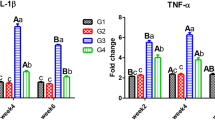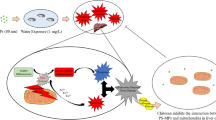Abstract
Cadmium (Cd) is a harmful heavy metal pollutant, which can cause oxidative stress in the body and induce cell damage. Reactive oxygen species (ROS) is a general term for substances that contain oxygen and are active in the body. However, excessive ROS can damage the body. Cadmium poisoning can cause a large amount of ROS in cells and autophagy. Astragalus polysaccharide (APS) is a plant polysaccharide with biological functions, such as antioxidant and anti-stress activities. In this study, chicken embryo fibroblasts (CEF) were used to determine the relationship between ROS and autophagy damage of Cd-infected cells and the mechanism of APS on cadmium-induced autophagy damage. The results showed that a 10-μL dose of 10 μmol/L cadmium chloride (CdCl2) can induce CEF autophagy and damage when CEF was added for 36 h. Cadmium induced CEF autophagy damage by increasing ROS production. APS could significantly reduce ROS production and LC3-II and Beclin-1 protein expression, increase the expression of mTOR and the level of antioxidation, and restore the viability and morphological damage of CEF exposed to Cd. Our study suggests that APS can alleviate Cd-induced CEF autophagy damage by reducing the production of ROS.









Similar content being viewed by others
References
Mera R, Torres E, Abalde J (2016) Influence of sulphate on the reduction of cadmium toxicity in the microalga Chlamydomonas moewusii. Ecotoxicol Environ Saf 128:236–245
Huo J, Dong A, Yan J, Wang L, Ma C, Lee S (2017) Cadmium toxicokinetics in the freshwater turtle, Chinemys reevesii. Chemosphere 182:392–398
Yang S, Zhang Z, He J, Li J, Zhang J, Xing H, Xu S (2012) Ovarian toxicity induced by dietary cadmium in hen. Biol Trace Elem Res 148(1):53–60
Zhang Q, Huang Y, Zhang K, Huang Y, Yan Y, Wang F, Wu J, Wang X, Xu Z, Chen Y et al (2016) Cadmium-induced immune abnormality is a key pathogenic event in human and rat models of preeclampsia. Environ Pollut 218:770–782
Van MG, Lombaert N, Lison D (2016) Dietary exposure to cadmium and risk of breast cancer in postmenopausal women: a systematic review and meta-analysis. Environ Int 86:1–13
O'Brien P, Salacinski HJ (1998) Evidence that the reactions of cadmium in the presence of metallothionein can produce hydroxyl radicals. Arch Toxicol 72(11):690–700
Valko M, Jomova K, Rhodes CJ, Kuča K, Musílek K (2016) Redox- and non-redox-metal-induced formation of free radicals and their role in human disease. Arch Toxicol 90(1):1–37
Onukwufor JO, MacDonald N, Kibenge F, Stevens D, Kamunde C (2014) Effects of hypoxia-cadmium interactions on rainbow trout (Oncorhynchus mykiss) mitochondrial bioenergetics: attenuation of hypoxia-induced proton leak by low doses of cadmium. J Exp Biol 217:831–840
Templeton DM, Liu Y (2010) Multiple roles of cadmium in cell death and survival. Chem Biol Interact 188(2):267–275
Ohsumi Y (2014) Historical landmarks of autophagy research. Cell Res 24(1):9–23
Xue JF, Shi ZM, Zou J, Li XL (2017) Inhibition of PI3K/AKT/mTOR signaling pathway promotes autophagy of articular chondrocytes and attenuates inflammatory response in rats with osteoarthritis. Biomed Pharmacother 89:1252–1261
Moloudizargari M, Asghari MH, Ghobadi E, Fallah M, Rasouli S, Abdollahi M (2017) Autophagy, its mechanisms and regulation: implications in neurodegenerative diseases. Ageing Res Rev 40:64–74
He C, Klionsky DJ (2009) Regulation mechanisms and signaling pathways of autophagy. Annu Rev Genet 43:67–93
Zi W, Jing W, Ling W (2016) Morphological analysis of the origin of autophagosomal membrane. J Chin Electron Microsc Soc 35:521–525
Yang A, Pantoom S, Wu YW (2017) Legionella Elucidation of the anti-autophagy mechanism of the effector RavZ using semisynthetic LC3 proteins. ELife 6. https://doi.org/10.7554/eLife.23905
Weh KM, Howell AB, Kresty LA (2016) Expression, modulation, and clinical correlates of the autophagy protein Beclin-1 in esophageal adenocarcinoma. Mol Carcinog 55(11):1876–1885
Sokolova IM, Evans S, Hughes FM (2004) Cadmium-induced apoptosis in oyster hemocytes involves disturbance of cellular energy balance but no mitochondrial permeability transition. J Exp Biol 207:3369–3380
Son YO, Wang X, Hitron JA, Zhang Z, Cheng S, Budhraja A, Ding S, Lee JC, Shi X (2011) Cadmium induces autophagy through ROS-dependent activation of the LKB1-AMPK signaling in skin epidermal cells. Toxicol Appl Pharmacol 255(3):287–296
Xie W, Ge M, Li G, Zhang L, Tang Z, Li R, Zhang R (2017) Astragalus polysaccharide protect against cadmium-induced cytotoxicity through the MDA5/NF-κB pathway in chicken peripheral blood lymphocytes. Molecules 22(10). https://doi.org/10.3390/molecules22101610
Rui W, Li C, Chen H (2019) Progress of structure characterization and biological activities of Astragalus polysaccharides. Tradit Chin Drug Res Clin Pharmacol 30:264–270
Tomoda M, Shimizu N, O Hara N, Gonda RK, Ishii S, O Tsuki H (1992) A reticuloendothelial system-activating glycan from the roots of Astragalus membranaceus. Phytochemistry 31(1):63–66
Xie L, Wu Y, Fan Z, Liu Y, Zeng J (2016) Astragalus polysaccharide protects human cardiac microvascular endothelial cells from hypoxia/reoxygenation injury: the role of PI3K/AKT, Bax/Bcl-2 and caspase-3. Mol Med Rep 14(1):904–910
Chen W, Sun Q, Ju J, Chen W, Zhao X, Zhang Y, Yang Y (2018) Effect of Astragalus polysaccharides on cardiac dysfunction in db/db Mice with respect to oxidant stress. Biomed Res Int 2018:8359013
Xue H, Gan F, Zhang Z, Hu J, Chen X, Huang K (2015) Astragalus polysaccharides inhibits PCV2 replication by inhibiting oxidative stress and blocking NF-κB pathway. Int J Biol Macromol 81:22–30
Zhang J, Gu J, Chen Z, Xing K, Sun B (2015) Astragalus polysaccharide suppresses palmitate-induced apoptosis in human cardiac myocytes: the role of Nrf1 and antioxidant response. Int J Clin Exp Pathol 8(3):2515–2524
An F, Yan C, Liu Y (2019) Protective effects of Astragalus polysaccharide on immune function injury and oxidative stress injury in rats exposed to cadmium. Chin J Gerontol 39:400–403
Hu B (2018) Study on optimization of extraction process of Astragalus polysaccharides and its antioxidant activity. China Pharmaceuticals 27:11–14
Yang X, Arslan M, Liu X, Song H, Du M, Li Y, Zhang Z (2020) IFN-γ establishes interferon-stimulated gene-mediated antiviral state against Newcastle disease virus in chicken fibroblasts. Acta Biochim Biophys Sin 52(3):268–280
Zhang R, Yu Q, Shi G, Liu R, Zhang W, Zhao X, Li G, Ge M (2017) chTLR4 pathway activation by Astragalus polysaccharide in bursa of Fabricius. BMC Vet Res 13(1):119
Martorana F, Gaglio D, Bianco MR, Aprea F, Virtuoso A, Bonanomi M, Alberghina L, Papa M, Colangelo AM (2018) Differentiation by nerve growth factor (NGF) involves mechanisms of crosstalk between energy homeostasis and mitochondrial remodeling. Cell Death Dis 9(3):391
Zuo R, Wang Y, Li J, Wu J, Wang W, Li B, Sun C, Wang Z, Shi C, Zhou Y et al (2019) Rapamycin induced autophagy inhibits inflammation-mediated endplate degeneration by enhancing Nrf2/Keap1 signaling of cartilage endplate stem cells. Stem Cells 37(6):828–840
Wang SH, Shih YL, Kuo TC, Ko WC, Shih CM (2009) Cadmium toxicity toward autophagy through ROS-activated GSK-3beta in mesangial cells. Toxicol Sci 108(1):124–131
Kar I, Patra A (2021) Tissue bioaccumulation and toxicopathological effects of cadmium and its dietary amelioration in poultry-a review. Biol Trace Elem Res. https://doi.org/10.1007/s12011-020-02503-2
Ni Z, Zhang Y, Deng C (2015) Expression of LC3 gene in cell autophagy. Hubei Agric Sci 54:4932–4936
Yamada T, Ichimura K, Kanekatsu M, van Doorn WG (2009) Homologs of genes associated with programmed cell death in animal cells are differentially expressed during senescence of Ipomoea nil petals. Plant Cell Physiol 50(3):610–625
Sahin E, Gümüşlü S (2004) Cold-stress-induced modulation of antioxidant defence: role of stressed conditions in tissue injury followed by protein oxidation and lipid peroxidation. Int J Biometeorol 48(4):165–171
Hu X, Zhang R, Xie Y, Wang H, Ge M (2017) The protective effects of polysaccharides from Agaricus blazei Murill against cadmium-induced oxidant stress and inflammatory damage in chicken livers. Biol Trace Elem Res 178(1):117–126
Yang F, Yan G, Li Y, Han Z, Zhang L, Chen S, Feng C, Huang Q, Ding F, Yu Y et al (2016) Astragalus polysaccharide attenuated iron overload-induced dysfunction of mesenchymal stem cells via suppressing mitochondrial ROS. Cell Physiol Biochem 39(4):1369–1379
Zhan X, Yan C, Chen Y, Wei X, Xiao J, Deng L, Yang Y, Qiu P, Chen Q (2018) Celastrol antagonizes high glucose-evoked podocyte injury, inflammation and insulin resistance by restoring the HO-1-mediated autophagy pathway. Mol Immunol 104:61–68
Li Q, Zhang H (2018) Radix Astragali polysaccharide extraction, chemical modification and effect of scavenging of free radicals. Shandong Chem Ind 47(11):44–45
Reddad Z, Gerente C, Andres Y, Le Cloirec P (2002) Modeling of single and competitive metal adsorption onto a natural polysaccharide. Environ Sci Technol 36(10):2242–2248
Liu Y, Liu F, Yang Y, Li D, Lv J, Ou Y, Sun F, Chen J, Shi Y, Xia P (2014) Astragalus polysaccharide ameliorates ionizing radiation-induced oxidative stress in mice. Int J Biol Macromol 68:209–214
Chen W, Ju J, Yang Y, Wang H, Chen W, Zhao X, Ye H, Zhang Y (2018) Astragalus polysaccharides protect cardiac stem and progenitor cells by the inhibition of oxidative stress-mediated apoptosis in diabetic hearts. Drug Des Devel Ther 12:943–954
Meng Q, Du X, Wang H, Gu H, Zhan J, Zhou Z (2017) Astragalus polysaccharides inhibits cell growth and pro-inflammatory response in IL-1β-stimulated fibroblast-like synoviocytes by enhancement of autophagy via PI3K/AKT/mTOR inhibition. Apoptosis 22(9):1138–1146
Lu L, Huang Y, Chen D, Wang M, Zou Y, Wan H, Wei L (2016) Astragalus polysaccharides decrease muscle wasting through Akt/mTOR, ubiquitin proteasome and autophagy signalling in 5/6 nephrectomised rats. J Ethnopharmacol 186:125–135
Cao Y, Shen T, Huang X, Lin Y, Chen B, Pang J, Li G, Wang Q, Zohrabian S, Duan C, Ruan Y, Man Y, Wang S, Li J (2017) Astragalus polysaccharide restores autophagic flux and improves cardiomyocyte function in doxorubicin-induced cardiotoxicity. Oncotarget 8(3):4837–4848
Yang Z, Klionsky DJ (2010) Mammalian autophagy: core molecular machinery and signaling regulation. Curr Opin Cell Biol 22(2):124–131
Lu Q, Yang P, Huang X, Hu W, Guo B, Wu F, Lin L, Kovács AL, Yu L, Zhang H (2011) The WD40 repeat PtdIns(3)P-binding protein EPG-6 regulates progression of omegasomes to autophagosomes. Dev Cell 21(2):343–357
Scarlatti F, Maffei R, Beau I, Codogno P, Ghidoni R (2008) Role of non-canonical Beclin 1-independent autophagy in cell death induced by resveratrol in human breast cancer cells. Cell Death Differ 15(8):1318–1329
Klionsky DJ, Abdalla FC, Abeliovich H, Abraham RT, Acevedo-Arozena A, Adeli K, Agholme L, Agnello M, Agostinis P, Aguirre-Ghiso JA et al (2012) Guidelines for the use and interpretation of assays for monitoring autophagy. Autophagy 8(4):445–544
Acknowledgements
We thank the members of the Traditional Chinese Veterinary Medicine Laboratory in the College of Veterinary Medicine, Northeast Agricultural University.
Funding
This work was supported by the National Science Foundation of China (Grant No. 31272533).
Author information
Authors and Affiliations
Corresponding author
Ethics declarations
Ethics Approval
Ethical treatment of animals used in this study was approved by the Animal Welfare Committee protocol (#NEAU-2013-02-0252-11) at Northeast Agricultural University (Harbin, China).
Conflict of Interest
The authors declare that they have no conflict of interest.
Disclaimer
All authors have read the manuscript and agreed to submit it in its current form for consideration for publication in the journal.
Additional information
Publisher’s Note
Springer Nature remains neutral with regard to jurisdictional claims in published maps and institutional affiliations.
Rights and permissions
About this article
Cite this article
Shen, X., Tang, Z., Bai, Y. et al. Astragalus Polysaccharide Protects Against Cadmium-Induced Autophagy Injury Through Reactive Oxygen Species (ROS) Pathway in Chicken Embryo Fibroblast. Biol Trace Elem Res 200, 318–329 (2022). https://doi.org/10.1007/s12011-021-02628-y
Received:
Accepted:
Published:
Issue Date:
DOI: https://doi.org/10.1007/s12011-021-02628-y




